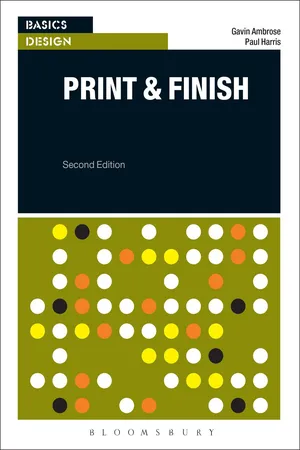![]()
Client: Coast
Design: Frost*
Technical overview: Blind deboss business cards
Coast
These business cards by Frost*, for restaurant Coast, feature a blind deboss, strategically placed on the horizon of the image. The accompanying invitation can be seen here.
Chapter 3
Finishing
Print finishing encompasses a wide range of processes that can provide the final touches to a design once the substrate has been printed. These processes include die cutting, embossing, debossing, foil blocking, varnishing and screen printing to name but a few, and can transform an ordinary looking piece into something much more arresting.
Finishing processes can add decorative elements to a printed piece, such as the shimmer of a foil block, or textural qualities, such as those produced by an emboss or deboss. Finishing techniques can also provide added functionality to a design, and even be a constituent part of a publication’s format. For example, a die cut alters the physical product, perhaps changing its shape or providing an aperture through which other parts of the publication can be viewed.
Although the application of print-finishing techniques signals the end of the production process, these techniques should not be considered as afterthoughts, but as an integral part of a design, and one that needs to be considered during the planning stage.
Varnishes
A varnish is a colourless coating that is often applied to a printed piece to protect the substrate from scuffing, wear or smudging. Varnish can also be used to enhance the visual appearance of a design, or elements within it. Varnish can produce three finishes – gloss, dull and satin – and, while not strictly a varnish, UV coating can also be used to add decorative touches to designs.
Applying a varnish increases colour absorption and speeds up the drying process. By ‘locking in’ the printing ink under a protective coat, the varnish helps to prevent the ink rubbing off when the substrate is handled.
Varnish can be applied in-line or ‘wet’; which essentially means it is treated as an additional colour during the printing process. A wet layer of varnish is applied on to a wet layer of ink, and both are absorbed into the stock as they dry, which reduces the visual impact of the varnish. An off-line varnish is applied once the printing inks have dried, and therefore less is absorbed by the stock. Varnish performs better on coated substrates, again because less is absorbed by the stock.
spot UV, clear and pearlescent varnishes.
spot UV, lamination and black varnish.
Varnishes can be used to produce different effects; as these details (above and opposite) taken from examples on the following pages, demonstrate.
Gloss
A gloss varnish reflects back light and is frequently used to enhance the appearance of photographs or other graphic elements in brochures, as it adds to the sharpness and saturation of images.
Matt (or dull)
A matt varnish is typically used with text-heavy pages to diffuse light, reduce glare and so increase readability. It gives a non-glossy, smooth finish to the printed page.
Satin (or silk)
A satin varnish is a middle option between the gloss and matt varnishes. It provides some highlight, but is not as flat as a matt finish.
Neutral
Machine sealing is the application of a basic, almost invisible, coating that seals the printing ink without affecting the appearance of the job. It is often used to accelerate the drying of fast turnaround print jobs (such as leaflets) on matt and satin papers, upon which inks dry more slowly.
UV varnish
UV varnish is a clear liquid that is applied like ink and cured instantly with ultraviolet light. It can provide either a gloss or matt coating. Increasingly, UV varnish is used as a spot covering to highlight a particular image because it provides more shine than varnish.
Full-bleed UV
The most common type of all-over UV coating, largely because it produces a very high gloss effect.
Spot UV
The varnish is applied to highlight discrete areas of a printed design, both visually and by imparting a different ...



